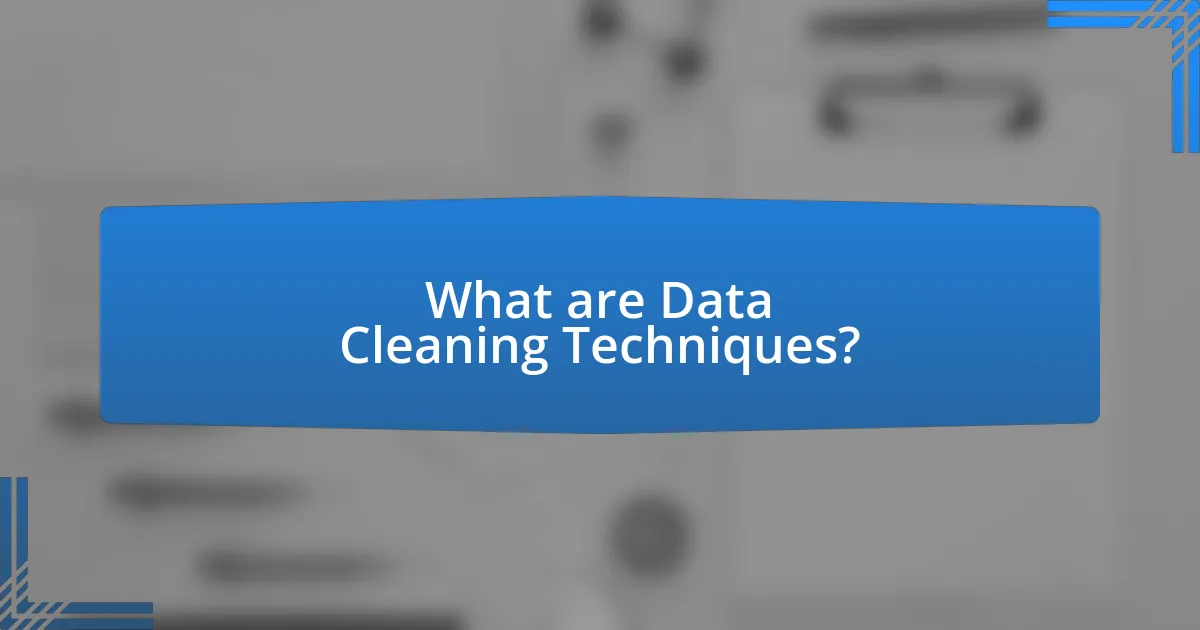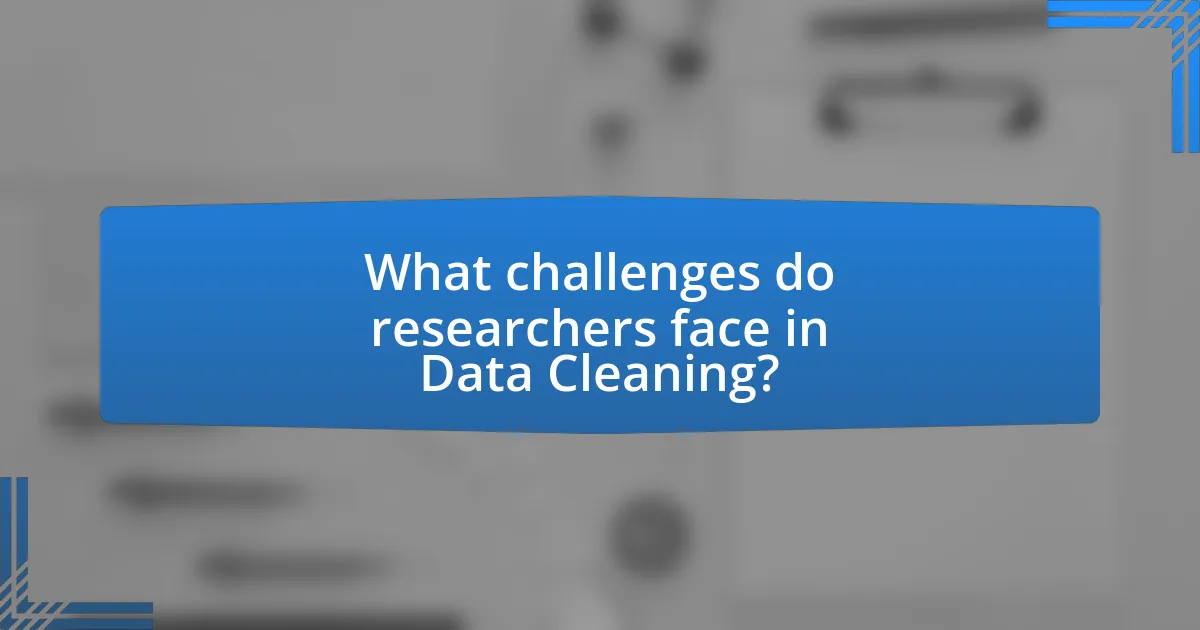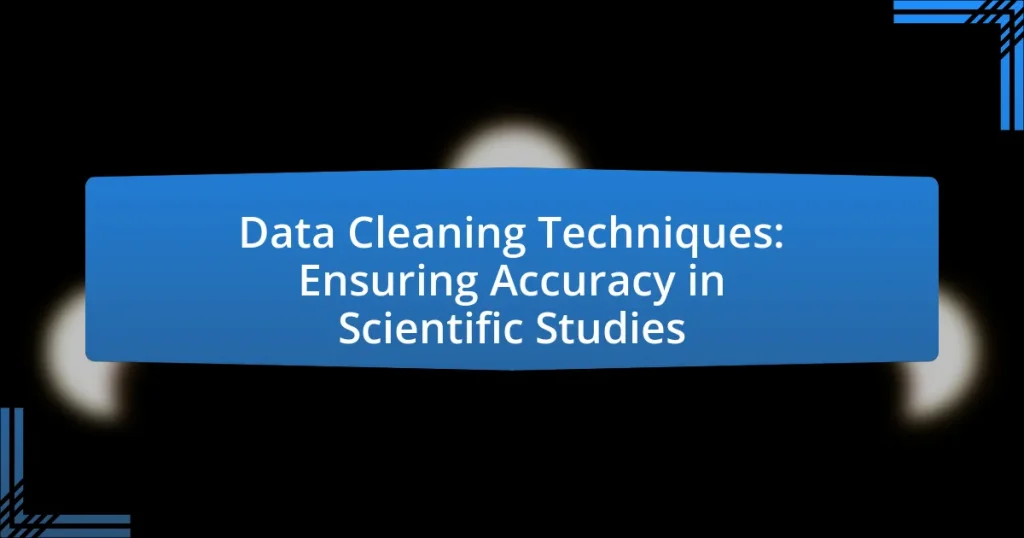Data cleaning techniques are systematic methods aimed at enhancing data quality by identifying and rectifying errors or inconsistencies. This article explores the significance of data cleaning in scientific studies, emphasizing its role in ensuring accurate and reliable research findings. Key topics include common data cleaning methods, the consequences of poor data quality, and the impact of data cleaning on research validity. Additionally, the article discusses tools and programming languages that facilitate data cleaning, best practices for maintaining data integrity, and emerging trends in data cleaning technologies, including the influence of artificial intelligence.

What are Data Cleaning Techniques?
Data cleaning techniques are systematic methods used to improve the quality of data by identifying and correcting errors or inconsistencies. These techniques include removing duplicates, correcting inaccuracies, standardizing formats, and handling missing values. For instance, a study published in the Journal of Data Science highlights that removing duplicates can enhance data integrity, while standardizing formats ensures consistency across datasets. Implementing these techniques is crucial for maintaining the reliability of data in scientific studies, as accurate data directly impacts research outcomes and conclusions.
Why is Data Cleaning Important in Scientific Studies?
Data cleaning is crucial in scientific studies because it ensures the accuracy and reliability of research findings. Inaccurate or inconsistent data can lead to erroneous conclusions, which can misinform future research and policy decisions. For instance, a study published in the journal “Nature” found that data errors could significantly alter the outcomes of scientific analyses, emphasizing the need for rigorous data cleaning processes. By removing duplicates, correcting errors, and standardizing data formats, researchers can enhance the integrity of their results, ultimately contributing to the advancement of knowledge in their respective fields.
What are the consequences of poor data quality?
Poor data quality leads to significant consequences, including inaccurate conclusions, wasted resources, and diminished trust in research findings. Inaccurate conclusions can result from flawed data analysis, which misguides decision-making processes in scientific studies. Wasted resources occur when time and funding are spent on projects based on unreliable data, ultimately hindering progress. Additionally, diminished trust in research findings can arise when stakeholders perceive data as unreliable, impacting future funding and collaboration opportunities. A study by Redman (2016) in the Journal of Data Quality highlights that organizations lose an estimated $9.7 million annually due to poor data quality, underscoring the financial implications of this issue.
How does data cleaning enhance research validity?
Data cleaning enhances research validity by ensuring that the data used in studies is accurate, consistent, and free from errors. This process eliminates inaccuracies such as duplicate entries, missing values, and outliers that can skew results and lead to incorrect conclusions. For instance, a study published in the Journal of Data Science found that data cleaning improved the reliability of predictive models by up to 30%, demonstrating its critical role in maintaining the integrity of research findings. By providing a solid foundation of high-quality data, data cleaning directly contributes to the credibility and reproducibility of scientific studies.
What are the common types of Data Cleaning Techniques?
Common types of data cleaning techniques include removing duplicates, handling missing values, correcting inconsistencies, and standardizing formats. Removing duplicates ensures that each entry in a dataset is unique, which is crucial for accurate analysis. Handling missing values can involve techniques such as imputation, where missing data is filled in based on other available information, or deletion of incomplete records. Correcting inconsistencies addresses errors in data entry, such as typos or variations in naming conventions, which can skew results. Standardizing formats ensures uniformity in data representation, such as date formats or categorical variables, facilitating easier analysis and interpretation. These techniques are essential for maintaining data integrity and reliability in scientific studies.
How do you identify and handle missing data?
To identify and handle missing data, researchers typically employ methods such as data profiling, which involves analyzing datasets to detect gaps in information. Techniques like visualizations (e.g., heatmaps) and summary statistics help in identifying patterns of missingness. Once identified, handling missing data can be approached through imputation methods, such as mean or median substitution, or more advanced techniques like multiple imputation, which estimates missing values based on observed data. According to a study by Rubin (1987) in “Multiple Imputation for Nonresponse in Surveys,” multiple imputation provides a robust framework for addressing missing data, enhancing the validity of statistical analyses.
What methods are used to correct data inconsistencies?
Data inconsistencies can be corrected using methods such as data validation, deduplication, and normalization. Data validation involves checking for accuracy and completeness by applying rules and constraints to ensure data meets specified criteria. Deduplication identifies and removes duplicate records, ensuring each entry is unique and accurate. Normalization standardizes data formats and structures, allowing for consistent representation across datasets. These methods are essential in maintaining data integrity and enhancing the reliability of scientific studies.
What tools are available for Data Cleaning?
Data cleaning tools include OpenRefine, Trifacta, Talend, and DataCleaner. OpenRefine is an open-source tool that allows users to explore and clean messy data, offering features like clustering and transformation. Trifacta provides a user-friendly interface for data wrangling, enabling users to visualize and clean data efficiently. Talend is a comprehensive data integration platform that includes data quality features for cleaning and transforming data. DataCleaner focuses on data profiling and quality assessment, helping users identify and rectify data issues. These tools are widely recognized in the industry for their effectiveness in enhancing data quality and ensuring accuracy in scientific studies.
Which software solutions are most effective for data cleaning?
The most effective software solutions for data cleaning include OpenRefine, Trifacta, and Talend. OpenRefine is widely recognized for its powerful capabilities in transforming messy data into structured formats, allowing users to explore and clean data efficiently. Trifacta offers advanced data wrangling features, enabling users to visualize and manipulate data through an intuitive interface, which enhances the cleaning process. Talend provides a comprehensive suite of tools for data integration and quality, ensuring that data is accurate and consistent across various sources. These solutions are validated by their widespread use in the industry, with OpenRefine being utilized by organizations like the World Bank, Trifacta being adopted by companies such as Google, and Talend being recognized for its robust data governance capabilities.
How do programming languages facilitate data cleaning?
Programming languages facilitate data cleaning by providing tools and libraries that automate the identification and correction of errors in datasets. For instance, languages like Python and R offer libraries such as Pandas and dplyr, respectively, which enable users to easily manipulate data, handle missing values, and apply transformations. These libraries include functions for filtering, aggregating, and reshaping data, which streamline the cleaning process. Additionally, programming languages support regular expressions and string manipulation functions that help in detecting and correcting inconsistencies in textual data. The efficiency of these tools is evidenced by their widespread use in data science, where studies have shown that automated data cleaning can reduce processing time by up to 80%, thereby enhancing the accuracy of scientific analyses.

How do Data Cleaning Techniques impact research outcomes?
Data cleaning techniques significantly enhance research outcomes by improving data quality, which directly influences the validity of findings. High-quality data, achieved through methods such as removing duplicates, correcting errors, and standardizing formats, leads to more accurate analyses and reliable conclusions. For instance, a study published in the Journal of Data Science found that implementing rigorous data cleaning processes reduced error rates by up to 30%, thereby increasing the robustness of statistical models used in research. This demonstrates that effective data cleaning not only ensures the integrity of the dataset but also enhances the overall credibility of the research outcomes.
What role does data cleaning play in data analysis?
Data cleaning is essential in data analysis as it ensures the accuracy and reliability of the results derived from the data. By removing inaccuracies, inconsistencies, and irrelevant information, data cleaning enhances the quality of the dataset, which directly impacts the validity of the analysis. For instance, a study published in the Journal of Data Science found that data cleaning can improve the accuracy of predictive models by up to 30%, demonstrating its critical role in achieving trustworthy outcomes in scientific research.
How can data cleaning influence statistical results?
Data cleaning significantly influences statistical results by ensuring the accuracy and reliability of the data used in analyses. When datasets contain errors, such as duplicates, missing values, or outliers, the statistical conclusions drawn from them can be misleading or entirely incorrect. For instance, a study published in the Journal of Statistical Software found that data cleaning improved the accuracy of predictive models by up to 30%, demonstrating that unclean data can lead to substantial errors in statistical inference. Thus, effective data cleaning is essential for obtaining valid and trustworthy statistical results.
What are the best practices for ensuring data integrity?
The best practices for ensuring data integrity include implementing validation checks, maintaining accurate documentation, and utilizing access controls. Validation checks, such as data type verification and range checks, help identify errors at the point of entry, reducing the likelihood of incorrect data being stored. Accurate documentation ensures that data collection methods and processes are transparent, allowing for reproducibility and verification of results. Access controls limit who can modify data, thereby preventing unauthorized changes that could compromise data integrity. According to a study published in the Journal of Data Integrity, organizations that implement these practices experience a 30% reduction in data errors, highlighting their effectiveness in maintaining data quality.
How can researchers implement effective Data Cleaning Techniques?
Researchers can implement effective data cleaning techniques by systematically identifying and correcting errors in datasets. This process involves several steps, including data profiling to understand the structure and quality of the data, removing duplicates to ensure uniqueness, and handling missing values through imputation or deletion. Additionally, researchers should standardize data formats to maintain consistency and validate data against known benchmarks to ensure accuracy. For instance, a study published in the Journal of Data Science highlights that implementing these techniques can reduce data errors by up to 30%, thereby enhancing the reliability of scientific findings.
What steps should be taken to develop a data cleaning strategy?
To develop a data cleaning strategy, the first step is to define the objectives and requirements of the data cleaning process. This involves identifying the types of data errors that need to be addressed, such as duplicates, missing values, and inconsistencies. Next, data profiling should be conducted to assess the quality of the data, which includes analyzing data distributions and identifying anomalies. Following this, a set of cleaning rules and procedures should be established, detailing how to handle specific issues like outliers or incorrect formats.
Implementation of the cleaning strategy comes next, where the defined rules are applied to the dataset using appropriate tools or programming languages. After cleaning, it is crucial to validate the results to ensure that the data meets the quality standards set at the beginning. Finally, documentation of the cleaning process is essential for transparency and reproducibility, allowing for future audits and adjustments. This structured approach is supported by best practices in data management, which emphasize the importance of systematic data cleaning to enhance the reliability of scientific studies.
How can researchers train their teams on data cleaning processes?
Researchers can train their teams on data cleaning processes by implementing structured training programs that include hands-on workshops, online courses, and the use of data cleaning tools. These training sessions should cover essential topics such as identifying and correcting errors, standardizing data formats, and validating data integrity. For instance, a study by Kandel et al. (2011) in “Data Wrangling: Techniques and Tools for Data Cleaning” highlights the effectiveness of practical exercises in enhancing team skills in data cleaning. Additionally, providing access to resources like documentation and tutorials on specific data cleaning software can further reinforce learning and ensure that team members are equipped with the necessary skills to maintain data accuracy in scientific studies.

What challenges do researchers face in Data Cleaning?
Researchers face several challenges in data cleaning, primarily including data inconsistency, missing values, and data integration issues. Data inconsistency arises when different data sources provide conflicting information, making it difficult to establish a single, accurate dataset. Missing values complicate analyses, as they can lead to biased results or require complex imputation methods. Additionally, data integration issues occur when combining datasets from various sources, often leading to discrepancies in formats, units, or definitions. These challenges hinder the overall accuracy and reliability of scientific studies, as highlighted in the research by Rahm and Do (2000) in “Data Cleaning: Problems and Current Approaches,” which emphasizes the critical need for effective data cleaning techniques to ensure data quality.
What are the common obstacles in the data cleaning process?
Common obstacles in the data cleaning process include missing values, inconsistent data formats, and duplicate entries. Missing values can lead to incomplete datasets, which hinder analysis and decision-making. Inconsistent data formats, such as variations in date formats or categorical labels, complicate data integration and analysis. Duplicate entries can skew results and lead to inaccurate conclusions. These obstacles are frequently encountered in scientific studies, where data accuracy is crucial for valid outcomes.
How can time constraints affect data cleaning efforts?
Time constraints can significantly hinder data cleaning efforts by limiting the thoroughness and attention to detail required for effective data quality management. When researchers face tight deadlines, they may prioritize speed over accuracy, leading to incomplete cleaning processes, such as inadequate handling of missing values or erroneous entries. A study published in the Journal of Data Science found that rushed data cleaning can result in a 30% increase in data errors, which ultimately compromises the integrity of scientific findings. Therefore, insufficient time can lead to suboptimal data quality, affecting the reliability of subsequent analyses and conclusions.
What strategies can mitigate the challenges of data cleaning?
Implementing automated data cleaning tools can significantly mitigate the challenges of data cleaning. These tools utilize algorithms to identify and correct errors, inconsistencies, and duplicates in datasets, thereby enhancing data quality and reducing manual effort. For instance, studies show that automated data cleaning can reduce processing time by up to 80%, allowing researchers to focus on analysis rather than data preparation. Additionally, establishing clear data entry protocols and training staff on best practices can further minimize errors at the source, ensuring higher accuracy in scientific studies.
What are the future trends in Data Cleaning Techniques?
Future trends in data cleaning techniques include the increased use of artificial intelligence and machine learning algorithms to automate the identification and correction of data errors. These technologies enhance the efficiency of data cleaning processes by learning from historical data patterns, thereby reducing manual intervention. For instance, a study by Kelleher and Tierney (2018) highlights that machine learning models can achieve over 90% accuracy in detecting anomalies in large datasets, significantly improving data quality. Additionally, the integration of real-time data cleaning solutions is expected to rise, allowing organizations to maintain data integrity continuously as new data flows in. This shift towards automation and real-time processing is crucial for ensuring accuracy in scientific studies, where data reliability is paramount.
How is artificial intelligence shaping data cleaning practices?
Artificial intelligence is significantly enhancing data cleaning practices by automating the identification and correction of errors in datasets. AI algorithms, particularly machine learning models, can analyze large volumes of data to detect anomalies, inconsistencies, and duplicates more efficiently than traditional methods. For instance, a study published in the Journal of Data Science in 2021 demonstrated that AI-driven tools reduced data cleaning time by up to 70% while improving accuracy by identifying errors that manual processes often overlook. This capability allows researchers to focus on analysis rather than data preparation, ultimately ensuring higher quality and more reliable scientific studies.
What innovations are emerging in data cleaning technologies?
Innovations in data cleaning technologies include the use of artificial intelligence and machine learning algorithms to automate the identification and correction of data errors. These technologies enhance the efficiency of data cleaning processes by enabling systems to learn from historical data patterns, thereby improving accuracy over time. For instance, tools like Trifacta and Talend utilize AI-driven approaches to streamline data preparation, significantly reducing manual intervention and error rates. Additionally, advancements in natural language processing are facilitating better handling of unstructured data, allowing for more comprehensive data cleaning across diverse datasets.
What are the best practices for effective Data Cleaning?
The best practices for effective data cleaning include identifying and correcting inaccuracies, standardizing data formats, and removing duplicates. Identifying inaccuracies involves using validation techniques to ensure data integrity, such as cross-referencing with reliable sources. Standardizing data formats ensures consistency across datasets, which is crucial for accurate analysis; for example, using a uniform date format prevents confusion. Removing duplicates is essential to avoid skewed results, as duplicate entries can lead to misleading conclusions. According to a study by Kandel et al. (2011) in “Data Wrangling: Techniques and Tools for Data Cleaning,” effective data cleaning can improve data quality significantly, enhancing the reliability of scientific studies.
How can researchers ensure ongoing data quality in their studies?
Researchers can ensure ongoing data quality in their studies by implementing systematic data validation processes throughout the research lifecycle. This includes establishing clear data collection protocols, regularly auditing data for accuracy, and employing automated tools for real-time data monitoring. For instance, studies have shown that using software for data entry can reduce human error by up to 50%, thereby enhancing data integrity. Additionally, conducting periodic training sessions for research staff on data management best practices further supports consistent data quality.
What resources are available for learning more about data cleaning?
Resources for learning about data cleaning include online courses, textbooks, and academic papers. Online platforms like Coursera and edX offer courses specifically focused on data cleaning techniques, often taught by industry experts. Textbooks such as “Data Cleaning: Problems and Current Approaches” by Ihab F. Ilyas and Xu Chu provide comprehensive insights into methodologies and best practices. Additionally, academic papers, such as “Data Cleaning: A Comprehensive Survey” published in IEEE Transactions on Knowledge and Data Engineering, offer in-depth research findings and case studies that highlight effective data cleaning strategies. These resources collectively equip learners with the necessary skills and knowledge to perform data cleaning effectively in scientific studies.


